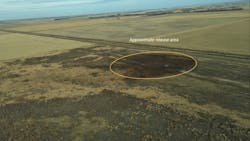South Dakota Oil Spill Highlights Concern for Keystone XL Pipeline Development
A major Keystone pipeline oil spill in South Dakota is driving growing concern about the pipeline’s safety, despite TransCanada’s reassurance that there is no environmental impact.
Media reports as well as a statement from TransCanada, the pipeline owner, confirm that 210,000 gallons of oil leaked into the ground in the town of Amherst.
The company denies any threat to public safety or other impact as the clean-up process commences, stating:
“Overnight and today TransCanada has continued to make progress in cleaning up the site. Through the work, we have also re-affirmed that the incident has been controlled and that there are no further environmental impacts observed and no threat to public safety. There are currently over 75 people supporting our incident response - specialists in environmental management, metallurgy, engineering, pipeline integrity and emergency response. TransCanada has mobilized a full complement of equipment on site including track hoes, earth movers, hydrovacs, bobcats, safety and emergency response equipment, vacuum trucks and high-powered lighting for around-the-clock operations.”
The source of the leak has not been identified, but it is under investigation, according to the company. Reports show a discrepancy between the time TransCanada discovered the spill and notified agencies and regulators about it.
The South Dakota Department of Environment and Natural Resources was not alerted about the spill until 10:30 a.m. CT on Thursday, Nov. 16, even though TransCanada knew about the leak at 5:30 a.m. CT, according to NPR.
TransCanada’s initial comments state the company acted immediately:
“As soon as we detected the first sign of an irregularity, TransCanada’s state of the art leak detection shut down the pipeline within minutes, notified state and federal regulatory agencies, local officials and nearby residents. TransCanada personnel also physically confirmed that valves located up and down the pipeline from the incident site have been properly closed.
Crews and equipment were dispatched and the area is being managed to ensure safety and security for personnel and residents. TransCanada workers and nationally recognized, industry leading experts (with proper safety equipment) began developing response plans. We continue to work methodically and around- the-clock on this process.”
The company also claimed that up-to-date information is being provided to impacted landowners, and agencies including the Pipeline and Hazardous Materials Safety Administration (PHMSA) and the South Dakota Department of Environment and Natural Resources currently are on site.
The construction and operation of the yet-to-be-built Keystone XL pipeline, what TransCanada calls a safer, “state-of-the-art” pipeline, has spurred opposition across the board from environmental groups, even before initial approval from President Donald Trump in March. Organization representatives and opposed parties responded almost immediately after the spill was reported.
“We’ve always said it’s not a question of whether a pipeline will spill, but when, and today TransCanada is making our case for us,” said Kelly Marthon, Sierra Club Beyond Dirty Fuels campaign director. “This is not the first time TransCanada’s pipeline has spilled toxic tar sands, and it won’t be the last. The PSC must take note: there is no such thing as a safe tar sands pipeline, and the only way to protect Nebraska communities from more tar sands spills is to say no to Keystone XL.”
This is not the first time the Keystone pipeline system has leaked. Keystone I, the original pipeline currently in operation and the source of the leak, had 12 spills in its first year. The incident occurs just days before Nebraska legislators will announce their decision about whether to allow construction of the pipeline through their state.
“Just days before the Nebraska Public Service Commission is set to make a historic decision on Keystone XL, a new tar sands pipeline, the writing on the wall to reject this pipeline could not be more clear,” said Rachel Rye Butler, Greenpeace Tar Sands campaigner. “These pipelines are bound to spill, and they put communities, precious drinking water, and our climate at risk. An approval of yet another pipeline is a mistake.”
